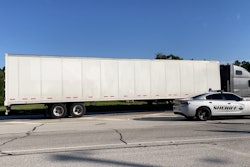Trucking news and briefs for Wednesday, April 24, 2024:
Truck tonnage fell in March
 After a 4% increase from January to February, ATA's Truck Tonnage Index fell 2% in March.ATA
After a 4% increase from January to February, ATA's Truck Tonnage Index fell 2% in March.ATA
The amount of freight hauled by trucks in March was down 1% year over year and down 2% from February, according to the American Trucking Associations’ advanced seasonally adjusted For-Hire Truck Tonnage Index. The 2% decline from February follows a 4% increase in February from January.
In March, the index equaled 113.4 compared with 115.7 in February.
“Tonnage in March suggests that truck freight volumes remain lackluster, and it is clear the truck freight recession continued through the first quarter,” said ATA Chief Economist Bob Costello. “In the first three months of 2024, ATA’s tonnage index contracted 0.8% from the previous quarter and declined 2.4% from a year earlier, highlighting ongoing challenges the industry is navigating.”
Compared with March 2023, the index fell 1%, which was the 13th straight year-over-year decline, but the second smallest over that period. In February, the index was down 1.7% from a year earlier.
The not seasonally adjusted index, which represents the change in tonnage actually hauled by the fleets before any seasonal adjustment, equaled 114.4 in March, 4.7% higher than in February. ATA’s For-Hire Truck Tonnage Index is dominated by contract freight as opposed to spot market freight.
[Related: Supply needs to get back into balance with demand, experts say]
Senators urge NHTSA to create automated driving system standards
A group of Senators last week penned a letter to the National Highway Traffic Safety Administration urging the agency to be more proactive and aggressive in addressing safety concerns related to automated driving technologies.
Sens. Edward Markey (D-Massachusetts) and Richard Blumenthal (D-Connecticut) authored the April 18 letter, which was cosigned by Sens. Elizabeth Warren (D-Massachusetts), Bernie Sanders (I-Vermont), Ben Ray Luján (D-New Mexico), and Peter Welch (D-Vermont).
The senators noted “several high-profile crashes” in the last few months that “have highlighted the risks that vehicles equipped with partially automated and Automated Driving Systems (ADS) pose for road users.” They added that NHTSA has initiated several investigations but has not taken further proactive steps to make these systems safe enough for U.S. roads.
“We cannot allow partially automated driving systems and automated driving systems to accelerate the road safety crisis,” the senators wrote in the letter. “NHTSA must take firm control of the wheel and steer manufacturers towards prioritizing safety.”
They added that “public roads are not a sandbox for manufacturers or operators to play in, and regulatory agencies like NHTSA should be highly cautious about providing lax pathways onto the road for dangerous vehicles.”
[Related: Public-private partnership pushes for safe and efficient deployment of AVs in Texas]
Specifically, the letter urges NHTSA to consider several policy actions that would make autonomous vehicles safer, including:
- Restrict driving systems to the roads they are designed for. Partially and fully automated driving systems are designed only for certain road environments, but some manufacturers allow these systems to be engaged anywhere.
- Investigate confusing marketing that misleads drivers, as partially automated driving systems are sometimes marketed as automated driving systems, leading to dangerous situations where drivers misunderstand the driving system’s capability.
- Explore requiring more robust data collection. Vehicle manufactures are required to provide crash data to NHTSA for certain crashes, but this data is often incomplete and insufficient to inform potential regulatory safety actions.
- Consider proactive standards to make autonomous vehicles safer. Outside of the Federal Motor Vehicle Safety Standards that every vehicle must comply with, there is no additional safety standard automated driving systems must meet to ensure the vehicles are safe enough for public roads.
- Regulate remote assistance operators. Many automated driving systems rely on remote assistance operators to monitor the driving system, but there are no standards governing the credentials, location, or responsibilities of these operators.
- Exercise significant caution before exempting autonomous vehicles from existing safety standards.
[Related: Kentucky lawmakers override veto of autonomous vehicle legislation]
Service One Transportation renews SmartWay partnership
Service One Transportation announced Tuesday that it has submitted and received approval for their current data submission to the SmartWay Transport Partnership, a collaboration between the Environmental Protection Agency and industry.
The SmartWay Transport Partnership provides a framework to assess the environmental and energy efficiency of goods movement supply chains.
Service One will continue to contribute to the partnership's savings of 379 million barrels of oil, $52 billion on fuel costs and 162 million metric tons of CO2, 2.8 million short tons of NOx and 114,000 short tons of PM. This is the equivalent of the annual electricity use in 24 million homes. By joining SmartWay Transport Partnership, Service One demonstrates its strong environmental leadership and corporate responsibility, the company said.
"For more than a decade, Service One Transportation has been a proud participant in the SmartWay Transport Partnership,” said Mike Myszewski, Vice President of Operations and Logistics. “Our mission to provide our customers with superior service while at the same time being a sustainability leader in transportation only reinforces our commitment to the SmartWay Partnership."











